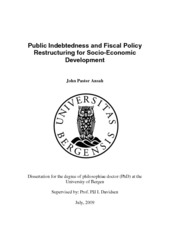Public Indebtedness and Fiscal Policy Restructuring for Socio-Economic Development
Doctoral thesis
Permanent lenke
https://hdl.handle.net/1956/3798Utgivelsesdato
2009-12-03Metadata
Vis full innførselSamlinger
- Department of Geography [634]
Sammendrag
The flow of finance across national boarders is not an exclusively twentieth century phenomenon(Korner, Maass et al. 1987). In the Middle Ages and later, in the early modern era, when creditoperations and modern banking were gradually beginning to develop, state spending was oftenfinanced with foreign money (Korner, Maass et al. 1987). While countries such as England, theUSA, Canada and Australia were able to initiate self-sustaining development based on foreignloans, the developing countries were already caught in the debt trap in the 19th century (Korner,Maass et al. 1987). The acquisition of foreign loans by developing countries to reduce povertyand underdevelopment has often plunged them into debt crises. As a consequence, debtorcountries were subjected to international financial control by IMF and the World Bank. Since themid-1970s an increasing number of developing countries have turned to IMF and negotiated aneconomic stabilization program in order to receive loans from IMF and the World Bank. In theearly 1980s public debt in developing countries raised questions concerning the ability ofdeveloping countries to service their debt, and Ghana was not an exception. Public debt hadgrown exponentially and the budget deficit continued to increase. Debt servicing continued toabsorb significant public revenue. It became apparent that public debt posed serious threats tosocio-economic development. Unsustainable public debt and poor economic growth in the 1980snecessitated the implementation of a Structural Adjustment Program by the IMF and the WorldBank. As the economy of Ghana recovers from the economic decline to the path of economicgrowth, public debt continues to increase considerably. It is imperative to understand the policyroots and structural mechanism that caused high public debt and its impact on socio-economicdevelopment in Ghana.
Består av
Paper 1: Ansah, J. P.; Qureshi, M. A., 2009, System Dynamics model of debt accumulation in developing countries: the case of Ghana and Pakistan. Full text not available in BORA.Paper 2: Ansah, J. P., 2009, The Dynamics of Public Indebtedness in Ghana. Full text not available in BORA.
Paper 3: Ansah, J. P.; Grosser, S., 2009, Economic Growth Accounting: Counterfactual Policy Analysis of Transitional Dynamics. Full text not available in BORA.
Paper 4: Ansah, J. P., 2009, Modeling the Dynamics of Poverty Traps and Debt Accumulation. Full text not available in BORA.
Paper 5: Ansah, J. P., 2009, Negotiating Fiscal Sustainability against Socio-Economic Development: A Model-Based Policy Analysis. Full text not available in BORA.
Paper 6: Ansah, J. P., 2009, Causal Analyses: Public Debt and Structural Adjustment. Full text not available in BORA.
